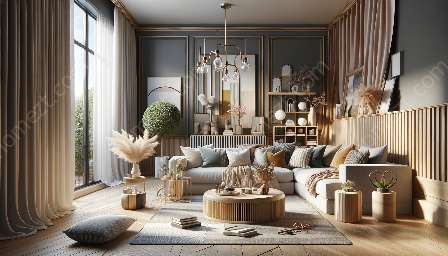Color plays a vital role in creating a harmonious and visually appealing space - be it your home or office. When it comes to homemaking and interior decor, the art of mixing and matching colors becomes a crucial aspect of creating a personalized and inviting environment. By understanding color schemes and palettes, you can leverage the power of colors to reflect your unique style and personality. In this comprehensive guide, we'll explore the principles of mixing and matching colors to help you infuse your living spaces with charm and character.
Understanding Color Schemes and Palettes
Before delving into the intricacies of mixing and matching colors, it's essential to have a strong grasp of color schemes and palettes. A color scheme refers to a set of colors that are used together to create a cohesive and aesthetically pleasing combination. There are various types of color schemes, such as monochromatic, analogous, complementary, and triadic, each offering its unique blend of harmony and contrast.
On the other hand, a color palette encompasses a broader range of colors that work well together and can be used to establish a unifying visual theme within a space. Palettes can be inspired by nature, art, fashion, or simply by your personal preferences.
Creating a Customized Look
When it comes to infusing your living spaces with a customized look, the key lies in the thoughtful incorporation of colors. Here are some expert tips for mixing and matching colors to achieve a personalized and visually captivating setup:
1. Start with a Base Color
Identify a base color that sets the tone for the entire space. This color will serve as the foundation and can be applied to larger areas such as walls, floors, or major furniture pieces. Neutral colors like white, beige, or gray are popular choices for base colors as they provide a versatile backdrop for incorporating accent colors.
2. Explore Harmonious Combinations
Building on the base color, explore harmonious combinations by choosing accent colors from the same color family. For example, if your base color is a soft shade of blue, consider incorporating complementary tones like aqua, teal, or navy to create a sense of harmony and fluidity within the space.
3. Embrace Contrast
While harmonious combinations are essential for a cohesive look, introducing elements of contrast can add depth and visual interest to the overall design. Experiment with bold accent colors or darker shades to create focal points or visual drama within the space.
4. Play with Texture and Finish
Color isn't just about hue; it also involves texture and finish. Mixing different textures and finishes of the same color can add depth and complexity to the overall aesthetic. Consider incorporating matte, glossy, or metallic finishes to create dynamic visual effects.
Inspiration for Personalized Color Schemes
Unleash your creativity and draw inspiration from various sources to craft a personalized and distinctive color scheme for your living spaces. Here are some avenues for inspiration:
Nature
Take cues from the natural world by observing the colors and patterns found in landscapes, flora, and fauna. Earthy tones, serene blues, vibrant greens, and warm autumnal hues can all serve as a rich source of inspiration for creating a nature-inspired color palette.
Art and Culture
Explore art, photography, and cultural traditions to discover unique color combinations and palettes. From the vibrant hues of traditional textiles to the subtle palettes of impressionist paintings, art and culture offer a plethora of possibilities for creating personalized color schemes.
Personal Preference
Ultimately, your personal preferences and lifestyle should guide the color choices for your living spaces. Whether you're drawn to bold, energetic colors or prefer a more muted and serene palette, your preferences play a pivotal role in curating a customized look that resonates with your individuality.
Enhancing Homemaking and Interior Decor
The right mix of colors can enrich the ambiance of any space, elevating the overall homemaking and interior decor experience. By applying the principles of mixing and matching colors, you can effortlessly enhance the aesthetic appeal and functionality of your living spaces. From creating a cozy and inviting atmosphere in your living room to infusing your kitchen with a touch of vibrancy, the possibilities are endless when it comes to leveraging the art of color harmony.
Coordinating Furniture and Accessories
When integrating customized color schemes into your interior decor, consider coordinating furniture and accessories to complement the chosen color palette. From selecting upholstery and drapery to choosing decorative accents and artwork, every element should contribute to the cohesive visual narrative of the space.
Personal Expression and Well-Being
Colors have the power to evoke emotions and reflect personal expression. By carefully curating a customized color scheme, you can create an environment that promotes relaxation, creativity, or productivity, depending on the intended function of the space. Pay keen attention to the psychological effects of different colors and their impact on well-being.
Conclusion
The art of mixing and matching colors for a customized look is a dynamic and rewarding endeavor that allows you to infuse your living spaces with personality and style. By understanding color schemes and palettes and drawing inspiration from various sources, you can craft a harmonious and personalized color scheme that enhances your homemaking and interior decor. Whether you're aiming for a sophisticated and elegant ambiance or a vibrant and eclectic atmosphere, the creative possibilities of color are limitless.
Embark on your color journey today and discover the transformative impact of customized color schemes on your living spaces!


